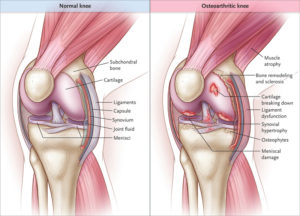
by Ellen Saltonstall
As our yoga population increases in age, teachers and students alike will be faced with osteoarthritis. Osteoarthritis is a slowly progressing degeneration of the protective structures inside a joint. The common term for this is “wear and tear”, or you could say “life with gravity”.
There are many types of arthritis, with osteoarthritis being by far the most common. Of those who have the condition, women outnumber men. Of all the joints that are most commonly afflicted, the knee joints are at the top of that list.
A healthy knee joint has articular cartilage coating the surface of the bones of the joint (the femur, tibia, and patella). That cartilage absorbs shock, and its glossy surface allows for easy movement. In addition, the joint capsule produces synovial fluid, which also enhances ease of movement.
An arthritic knee shows damage to the cartilage, with rough patches preventing the smooth glide of the bones. With less padding, the bone will grow osteophytes (bumps) and other types of bone remodeling may occur, further limiting movement and causing pain. Inflammation causes changes in the chemistry of the joint fluids. With pain, the biomechanics (movement habits) change enough to strain the ligaments and tendons as well.
The image above shows both a healthy knee joint and an arthritic one.
Once we have pain, we may refrain from moving the joint to avoid that pain, fearing further damage. But the old adage “Move it or lose it” rings true with osteoarthritis. Our joints need rest, but they also need movement. Careful movement with good alignment will promote the flow of the synovial fluid, which feeds the cartilage, and help to maintain strength and flexibility. We are born to move, but we have the responsibility to move intelligently. A carefully chosen yoga routine can take your knees through their range of motion safely, without the impact of most sports.
The degeneration of the articular cartilage is the main feature of knee arthritis. The causes of this in poorly understood, but here’s what we do know:
Causes we can’t control:
- Age—Prevalence increases between the ages of 50-60, and with life-expectancy increasing, more people are dealing with osteoarthritis.
- Genetic profile—There are inherited defects involving cartilage maintenance.
- Trauma—Any accident that impacts the knees can initiate an inflammatory process.
Causes we can control:
- Muscular weakness, stiffness, or imbalance—I’ll provide information about how to use yoga to improve muscular weakness, stiffness, and imbalance in my next post.
- Alignment issues that create excessive strain in specific areas—I’ll provide information about how to use yoga to improve alignment in my next post.
- Over-enthusiasm with fitness regimes like running, weightlifting, or cycling, especially with poor alignment—Whatever your fitness regime, there’s a fine line between enough and too much. Each of us has to determine that line for ourselves, sometimes by trial and error. Repetitive strain can hasten the progress of osteoarthritis, especially with alignment that increases our risks.
- Risky everyday movement habits—Bring awareness to how you move in various ways throughout the day and how your knees are aligned. How do you position your legs when you’re at your desk? Can you align your knees well while climbing stairs, getting in and out of a chair, or getting down onto the floor? In each of those situations, the principle of bending the knees toward the middle toes is a necessary skill that could require extra attention, but it’s worth it. When I work with private students, we discuss their daily activities and we simulate them in the session, to refine skills. I’ll provide more information about aligning your knees in my next post.
- Overweight—The pressure on each joint increases, from the neck down to the feet. Research (see here) has shown that overweight women have 4 times the risk of knee osteoarthritis, and for men that risk is 5 times greater. Any weight loss program that works for you is worth a try.
- Poor shoes—The shoes you wear will determine how skillfully you can align your feet and knees. Look for shoes with enough space and support, and shoes that allow good foot mechanics—in other words, they should move with your feet. Stiff or poorly fitting shoes will put excessive strain in the knees.
- Diet—Osteoarthritis is an inflammatory process, and our diet can contribute to that, for better or worse. A full discussion of this issue is beyond the scope of this post, but I recommend researching which foods in your diet might be contributing to inflammation overall and which foods or nutrients from supplements might help slow the progress of osteoarthritis.
In part two of my series on arthritis of the knees I’ll provide lots of information about how you can use yoga to prevent the development of or slow the progression of osteoarthritis of the knees. For now, here are four guidelines:
1. Keep moving, with daily walking and basic yoga (more about that in part two).
2. Examine and tweak your yoga practice, aiming for careful alignment and creative use of props, especially when doing seated poses. Useful props are chairs, blocks, blankets, and towels.
3. Do not work through pain, and avoid forcing in any pose; treat your joints respectfully.
4. If you’re a teacher and you wonder why a lifetime of yoga didn’t prevent you from having osteoarthritis, release that thought. Instead, remember that you can help your students with osteoarthritis more effectively because of your experience.
 Ellen Saltonstall, ERYT-500, C-IAYT, YACEP is an alignment-based yoga instructor and body therapist based in New York City with over 40 years of experience. Her background includes modern dance, a massage therapy practice, Iyengar Yoga and Anusara Yoga. She was certified in Anusara Yoga in 2001, then became a Subject Matter Specialist in anatomy and therapeutics. In addition to yoga, she teaches Bodymind Ballwork, a method of bodywork using rubber balls to facilitate tension release. Her published books include Yoga for Arthritis (2008), Yoga for Osteoporosis (2010), Anatomy and Yoga (2016), and The Bodymind Ballwork Method (2018). She offers yoga therapy webinars through YogaOnlineU.com, and she teaches nationally and internationally with a specialty in anatomy and therapeutics. She is known for her clarity, depth of knowledge, and enthusiasm in encouraging students of all levels to find freedom and joy through yoga. More information here.
Ellen Saltonstall, ERYT-500, C-IAYT, YACEP is an alignment-based yoga instructor and body therapist based in New York City with over 40 years of experience. Her background includes modern dance, a massage therapy practice, Iyengar Yoga and Anusara Yoga. She was certified in Anusara Yoga in 2001, then became a Subject Matter Specialist in anatomy and therapeutics. In addition to yoga, she teaches Bodymind Ballwork, a method of bodywork using rubber balls to facilitate tension release. Her published books include Yoga for Arthritis (2008), Yoga for Osteoporosis (2010), Anatomy and Yoga (2016), and The Bodymind Ballwork Method (2018). She offers yoga therapy webinars through YogaOnlineU.com, and she teaches nationally and internationally with a specialty in anatomy and therapeutics. She is known for her clarity, depth of knowledge, and enthusiasm in encouraging students of all levels to find freedom and joy through yoga. More information here.
• Follow Yoga for Healthy Aging on Facebook and follow Nina on Instagram • Order Yoga for Times of Change here and purchase the companion videos here • Order Yoga for Healthy Aging: A Guide to Lifelong Well-Being here.


Leave A Comment